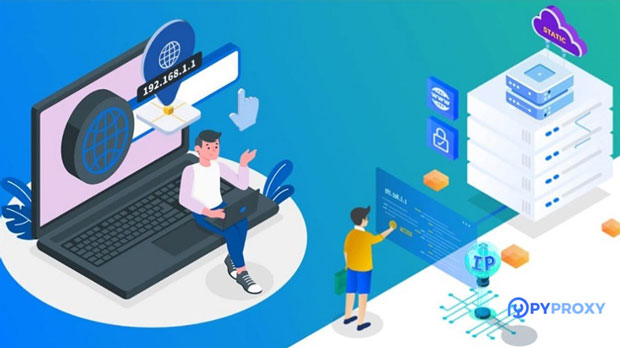In the world of data collection, the tools used for gathering and managing information are just as important as the data itself. Static residential proxy servers are often seen as a reliable method for large-scale data scraping, thanks to their ability to mask the origin of internet requests. This article explores the suitability of static residential proxy servers for large-scale data collection, covering their advantages, challenges, and how they can be effectively used in such operations. Understanding Static Residential Proxy ServersStatic residential proxy servers are proxies that assign a fixed IP address to the user, which remains the same throughout the duration of their session. These proxies are linked to real residential IP addresses, which means the server’s IP address is registered to a real household or business, making it appear like a legitimate internet user’s request. This gives static residential proxies an edge over datacenter proxies, which are often flagged by websites as suspicious or bots.The Role of Static Residential Proxy Servers in Large-Scale Data CollectionData collection at a large scale involves scraping websites, gathering content, and performing extensive market research or analytics. In such cases, it is essential to use a proxy that can handle the demands of massive data extraction without being blocked or detected by websites. static residential proxies are uniquely suited for this task as they offer the following benefits:- Bypassing Geo-blocks: Static residential proxies can be used to access geographically restricted content by selecting an IP address from a specific region.- Reduced Risk of Detection: Since the IP addresses come from real devices, websites are less likely to flag requests as coming from bots or scrapers.- High Availability and Reliability: These proxies are not only stable but also available 24/7, making them ideal for large-scale data collection that requires continuous access.Advantages of Using Static Residential Proxies for Data CollectionWhen it comes to large-scale data scraping, there are several clear advantages of using static residential proxies:- Anonymity and Security: Static residential proxies offer a higher level of anonymity compared to other proxy types, making them more secure for tasks that involve sensitive or private data.- IP Rotation Control: While some proxies may rotate IPs randomly, static residential proxies maintain the same IP address, giving users the ability to conduct stable and uninterrupted data collection over extended periods.- Avoiding Rate-Limiting: Websites often limit the number of requests from a single IP address, but with static residential proxies, users can make numerous requests without being detected, thus bypassing rate-limiting mechanisms.Challenges of Using Static Residential Proxies for Large-Scale Data CollectionAlthough static residential proxies have several advantages, they also come with a few challenges that should be considered before use in large-scale data collection projects:- Cost: Static residential proxies are typically more expensive than datacenter proxies. The price is reflective of their higher reliability and the fact that they use real residential IP addresses.- Bandwidth Limitations: Since these proxies are assigned to real households, they may come with bandwidth limits or slower speeds compared to other proxy types. This could slow down large-scale data scraping operations that require high-speed data extraction.- Legal and Ethical Considerations: Using static residential proxies may raise ethical and legal concerns, especially if they are being used to bypass regional restrictions or scrape content without permission. Users should ensure they are compliant with relevant laws and website terms of service.How to Use Static Residential Proxies Effectively in Large-Scale Data CollectionTo maximize the effectiveness of static residential proxies in large-scale data scraping, it’s crucial to follow best practices and optimize usage:- Choose a Reliable Proxy Provider: Not all proxy providers offer the same quality. It's important to choose a provider with a track record of reliability and high-quality proxies.- Maintain a Balanced Request Rate: To avoid detection, ensure that the rate of requests sent through proxies is consistent and does not exceed reasonable limits. Rapid, excessive requests are a red flag for websites.- Monitor Proxy Performance: Regular monitoring of proxy performance, including IP availability, request success rates, and speed, will help optimize data scraping operations and prevent issues.- Use CAPTCHA Solving Tools: Many websites use CAPTCHAs to prevent automated data scraping. Integrating CAPTCHA-solving tools with static residential proxies can help maintain the continuity of the data extraction process.Conclusion: Are Static Residential Proxies Right for Large-Scale Data Collection?Static residential proxy servers offer a compelling solution for large-scale data collection, with numerous advantages such as anonymity, reduced risk of detection, and the ability to bypass geo-blocks. However, the associated costs, bandwidth limitations, and potential legal challenges must be carefully weighed. By following best practices and using reliable proxy providers, businesses can leverage static residential proxies for effective and efficient data scraping operations. While they are not without their challenges, for many large-scale data collection projects, static residential proxies remain an invaluable tool.---Translation to English:Is Static Residential Proxy Server Suitable for Large-Scale Data Collection?In the world of data collection, the tools used for gathering and managing information are just as important as the data itself. Static residential proxy servers are often seen as a reliable method for large-scale data scraping, thanks to their ability to mask the origin of internet requests. This article explores the suitability of static residential proxy servers for large-scale data collection, covering their advantages, challenges, and how they can be effectively used in such operations.Understanding Static Residential Proxy ServersStatic residential proxy servers are proxies that assign a fixed IP address to the user, which remains the same throughout the duration of their session. These proxies are linked to real residential IP addresses, which means the server’s IP address is registered to a real household or business, making it appear like a legitimate internet user’s request. This gives static residential proxies an edge over datacenter proxies, which are often flagged by websites as suspicious or bots.The Role of Static Residential Proxy Servers in Large-Scale Data CollectionData collection at a large scale involves scraping websites, gathering content, and performing extensive market research or analytics. In such cases, it is essential to use a proxy that can handle the demands of massive data extraction without being blocked or detected by websites. Static residential proxies are uniquely suited for this task as they offer the following benefits:- Bypassing Geo-blocks: Static residential proxies can be used to access geographically restricted content by selecting an IP address from a specific region.- Reduced Risk of Detection: Since the IP addresses come from real devices, websites are less likely to flag requests as coming from bots or scrapers.- High Availability and Reliability: These proxies are not only stable but also available 24/7, making them ideal for large-scale data collection that requires continuous access.Advantages of Using Static Residential Proxies for Data CollectionWhen it comes to large-scale data scraping, there are several clear advantages of using static residential proxies:- Anonymity and Security: Static residential proxies offer a higher level of anonymity compared to other proxy types, making them more secure for tasks that involve sensitive or private data.- IP Rotation Control: While some proxies may rotate IPs randomly, static residential proxies maintain the same IP address, giving users the ability to conduct stable and uninterrupted data collection over extended periods.- Avoiding Rate-Limiting: Websites often limit the number of requests from a single IP address, but with static residential proxies, users can make numerous requests without being detected, thus bypassing rate-limiting mechanisms.Challenges of Using Static Residential Proxies for Large-Scale Data CollectionAlthough static residential proxies have several advantages, they also come with a few challenges that should be considered before use in large-scale data collection projects:- Cost: Static residential proxies are typically more expensive than datacenter proxies. The price is reflective of their higher reliability and the fact that they use real residential IP addresses.- Bandwidth Limitations: Since these proxies are assigned to real households, they may come with bandwidth limits or slower speeds compared to other proxy types. This could slow down large-scale data scraping operations that require high-speed data extraction.- Legal and Ethical Considerations: Using static residential proxies may raise ethical and legal concerns, especially if they are being used to bypass regional restrictions or scrape content without permission. Users should ensure they are compliant with relevant laws and website terms of service.How to Use Static Residential Proxies Effectively in Large-Scale Data CollectionTo maximize the effectiveness of static residential proxies in large-scale data scraping, it’s crucial to follow best practices and optimize usage:- Choose a Reliable Proxy Provider: Not all proxy providers offer the same quality. It's important to choose a provider with a track record of reliability and high-quality proxies.- Maintain a Balanced Request Rate: To avoid detection, ensure that the rate of requests sent through proxies is consistent and does not exceed reasonable limits. Rapid, excessive requests are a red flag for websites.- Monitor Proxy Performance: Regular monitoring of proxy performance, including IP availability, request success rates, and speed, will help optimize data scraping operations and prevent issues.- Use CAPTCHA Solving Tools: Many websites use CAPTCHAs to prevent automated data scraping. Integrating CAPTCHA-solving tools with static residential proxies can help maintain the continuity of the data extraction process.Conclusion: Are Static Residential Proxies Right for Large-Scale Data Collection?Static residential proxy servers offer a compelling solution for large-scale data collection, with numerous advantages such as anonymity, reduced risk of detection, and the ability to bypass geo-blocks. However, the associated costs, bandwidth limitations, and potential legal challenges must
Oct 09, 2025



































































